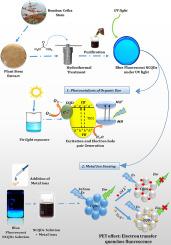木棉茎中n掺杂碳量子点的生态合成:Fe3+/Cd2+和染料降解的探索性光物理研究
IF 6.7
2区 工程技术
Q1 ENGINEERING, CHEMICAL
引用次数: 0
摘要
本研究报道了一种绿色、快速、可持续的连续水热合成氮掺杂碳量子点(N-CQDs)的方法,该方法以热带生物质木棉为碳前体,尿素为氮源。在365 nm紫外光激发下,N-CQDs具有较高的蓝色荧光发射,可用于荧光传感和光催化。高分辨率光谱、显微镜和表面分析足以全面表征N-CQDs和N-CQDs/TiO2,以确定其光学特性、形貌、元素组成和表面极性。将N-CQDs与TiO2混合,在可见光环境条件下得到N-CQDs/TiO2复合材料,实现光催化反应。这些N-CQDs通过荧光猝灭实现了对Fe3+和Cd2+离子的特异性靶向,对Fe3+的灵敏度响应最强,最低检出限(LOD)为1.9 μM,远低于WHO设定的指导阈值,在环境监测中具有一定的适用性。以亚甲基蓝(MB)作为常见的有机染料作为模型污染物测量光催化活性,在可见光下N-CQDs/TiO2复合材料的降解率为88%,优于纯TiO2(44%)和纯N-CQDs(75%)在可见光下的降解率。本研究突出了N-CQDs的双重功能;一是作为重金属离子的传感器,二是作为染料分解的光催化剂,在环境修复中具有广阔的应用前景。本文章由计算机程序翻译,如有差异,请以英文原文为准。

Eco-friendly synthesis of N-doped carbon quantum dots from Bombax ceiba stem: A photophysical study with exploratory sensing of Fe3+/Cd2+ and dye degradation
This study reports a green, rapid, and sustainable continuous hydrothermal synthesis of nitrogen-doped carbon quantum dots (N-CQDs) derived using the tropical biomass Bombax ceiba as a new carbon precursor along with urea as a nitrogen source. The N-CQDs showed high blue fluorescence emissions when excited with 365 nm UV light and can be used in fluorescence sensing and photocatalysis. High-resolution spectroscopy, microscopy, and surface analysis were adequate to characterize N-CQDs and N-CQDs/TiO2 comprehensively to confirm their optical characteristics, morphology, elemental composition, and surface polarity. N-CQDs were mixed with TiO2 to attain N-CQDs/TiO2 composites at ambient conditions under visible light to achieve photocatalytic responses. These N-CQDs achieved specific targeting of the Fe3+ and Cd2+ ions by fluorescence quenching, whose sensitivity had the strongest response to the tested Fe3+ and lowest limit of detection (LOD) of 1.9 μM, which is far below the guideline threshold set out by WHO, indicating their possible applicability in environmental monitoring. Methylene Blue (MB) was used as a common organic dye as a model pollutant to measure photocatalytic activity, with degradation being 88 % under visibly illuminated N-CQDs/TiO2 composite, degraded better than both pure TiO2 (44 %) and pure N-CQDs (75 %) under visible light. This research highlights the dual functionality of N-CQDs; firstly, as sensors to sense heavy metal ions and secondly as photocatalysts in decomposing dyes, offering a prospective application to environmental remediation.
求助全文
通过发布文献求助,成功后即可免费获取论文全文。
去求助
来源期刊

Journal of water process engineering
Biochemistry, Genetics and Molecular Biology-Biotechnology
CiteScore
10.70
自引率
8.60%
发文量
846
审稿时长
24 days
期刊介绍:
The Journal of Water Process Engineering aims to publish refereed, high-quality research papers with significant novelty and impact in all areas of the engineering of water and wastewater processing . Papers on advanced and novel treatment processes and technologies are particularly welcome. The Journal considers papers in areas such as nanotechnology and biotechnology applications in water, novel oxidation and separation processes, membrane processes (except those for desalination) , catalytic processes for the removal of water contaminants, sustainable processes, water reuse and recycling, water use and wastewater minimization, integrated/hybrid technology, process modeling of water treatment and novel treatment processes. Submissions on the subject of adsorbents, including standard measurements of adsorption kinetics and equilibrium will only be considered if there is a genuine case for novelty and contribution, for example highly novel, sustainable adsorbents and their use: papers on activated carbon-type materials derived from natural matter, or surfactant-modified clays and related minerals, would not fulfil this criterion. The Journal particularly welcomes contributions involving environmentally, economically and socially sustainable technology for water treatment, including those which are energy-efficient, with minimal or no chemical consumption, and capable of water recycling and reuse that minimizes the direct disposal of wastewater to the aquatic environment. Papers that describe novel ideas for solving issues related to water quality and availability are also welcome, as are those that show the transfer of techniques from other disciplines. The Journal will consider papers dealing with processes for various water matrices including drinking water (except desalination), domestic, urban and industrial wastewaters, in addition to their residues. It is expected that the journal will be of particular relevance to chemical and process engineers working in the field. The Journal welcomes Full Text papers, Short Communications, State-of-the-Art Reviews and Letters to Editors and Case Studies
 求助内容:
求助内容: 应助结果提醒方式:
应助结果提醒方式:


